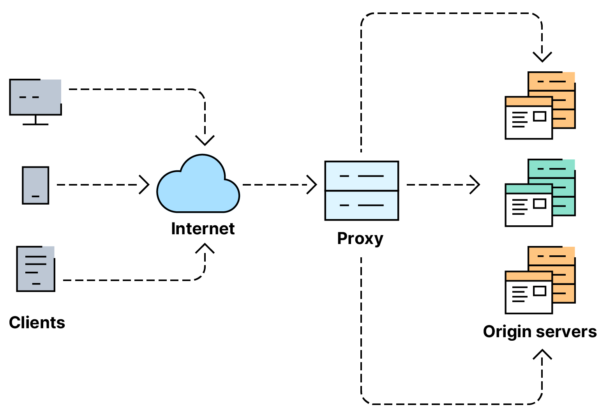Brief Information about Load Balancing:
Load balancing is a critical networking concept employed to efficiently distribute incoming network traffic across multiple servers or resources. Its primary goal is to prevent any single server from becoming overwhelmed, ensuring high availability, reliability, and performance for end-users.
Detailed Information about Load Balancing:
Load balancing is a technique used in networking to distribute incoming traffic across multiple servers or resources. By evenly distributing the workload, it prevents any single server from becoming overwhelmed, thus optimizing resource utilization and ensuring high availability and reliability for users accessing the network or service.
Key Features of Load Balancing:
Load balancing offers several key features essential for managing network traffic effectively:
- Scalability: Load balancers enable horizontal scaling by distributing incoming traffic across multiple servers or resources, allowing for seamless expansion as demand increases.
- High Availability: By distributing traffic across multiple servers, load balancers enhance fault tolerance and ensure continuous availability of services, even in the event of server failures.
- Performance Optimization: Load balancers intelligently route traffic based on various factors such as server health, load, and proximity to the client, thereby optimizing performance and reducing latency.
- Session Persistence: Some load balancing algorithms support session persistence, ensuring that subsequent requests from the same client are directed to the same server, maintaining session state and user experience.
Types of Load Balancing:
Load balancing can be implemented using various algorithms and techniques, including:
- Round Robin: Distributes incoming traffic evenly across a group of servers in a sequential manner.
- Least Connections: Routes traffic to the server with the fewest active connections, thereby evenly distributing the load.
- Weighted Round Robin: Assigns a weight to each server based on its capacity, directing more traffic to higher-capacity servers.
- IP Hash: Uses the client’s IP address to determine which server to send the request to, ensuring session persistence.
- Layer 4 vs. Layer 7 Load Balancing: Layer 4 load balancing operates at the transport layer and forwards traffic based on IP addresses and ports, while Layer 7 load balancing operates at the application layer, making routing decisions based on application-specific data.
Ways to Use Load Balancing:
Load balancing is employed in various scenarios to improve performance, reliability, and scalability:
- Web Server Clustering: Distributing web traffic across multiple servers to handle increased demand and ensure fault tolerance.
- Database Load Balancing: Diverting database queries to different database servers to prevent overload and improve query response times.
- Content Delivery Networks (CDNs): Using load balancers to distribute content to edge servers closer to end-users, reducing latency and improving content delivery speed.
- Application Load Balancing: Optimizing traffic distribution for complex applications with multiple components or microservices.
Problems and Solutions with Load Balancing:
While load balancing offers numerous benefits, several challenges may arise:
- Single Point of Failure: Load balancers themselves can become a single point of failure. Implementing redundancy and failover mechanisms can mitigate this risk.
- Algorithm Overhead: Some load balancing algorithms may introduce additional overhead, impacting performance. Choosing the right algorithm and optimizing configurations can address this issue.
- Session Affinity: Ensuring session persistence across servers can be challenging, especially in stateful applications. Employing techniques like sticky sessions or session replication can help maintain session state.
- Complexity and Management: Managing and configuring load balancers in dynamic environments can be complex. Automation and centralized management solutions can streamline administration tasks.
Main Characteristics and Comparisons:
| Characteristic | Load Balancing | Similar Terms |
|---|---|---|
| Traffic Distribution | Distributes incoming traffic across multiple servers | Traffic Shaping, Traffic Steering |
| Scalability | Facilitates horizontal scaling by adding more servers | Horizontal Scaling, Elastic Load Balancing |
| Availability | Ensures high availability by redirecting traffic as needed | High Availability, Fault Tolerance |
| Performance Optimization | Optimizes performance by routing traffic efficiently | Performance Tuning, Traffic Optimization |
Perspectives and Future Technologies:
The future of load balancing is marked by advancements in automation, AI-driven decision-making, and integration with emerging technologies such as edge computing and serverless architectures. Machine learning algorithms can dynamically adapt load balancing strategies based on real-time traffic patterns, improving efficiency and response times. Additionally, the integration of load balancers with edge computing infrastructures enables more localized traffic routing, reducing latency and enhancing user experiences.
VPN and Load Balancing:
Load balancing can be integrated with VPN (Virtual Private Network) services to optimize traffic distribution and enhance performance for VPN users. By deploying load balancers across multiple VPN servers, incoming VPN connections can be evenly distributed, reducing server load and ensuring consistent performance. This approach also enhances fault tolerance, as VPN traffic can be rerouted to alternate servers in the event of server failures, maintaining uninterrupted VPN connectivity for users.
Links to Resources:
For further information on load balancing and related topics, refer to the following resources:
- Microsoft Azure Load Balancer Overview
- AWS Elastic Load Balancing Documentation
- NGINX Load Balancing Guide
By leveraging load balancing techniques, organizations can optimize their network infrastructure, improve service reliability, and deliver superior user experiences across various applications and services.


